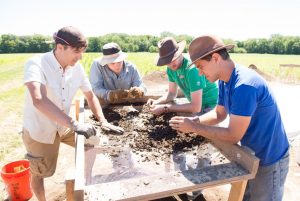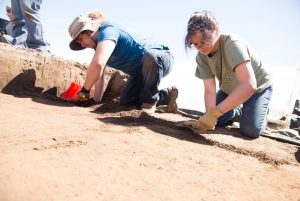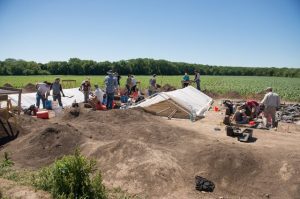ISU students dig into history of 800-year-old village
Illinois State U. News — July 15, 2018
Illinois State Professor Logan Miller (front, right) and his students sift through the collected soil in search of artifacts. (Photo courtesy of Illinois State U.)
Molly McManus found a special birthday surprise last June in a cornfield about 10 miles south of Bloomington.
The senior anthropology major was shoveling deep into a layer of clay-thick black soil when she struck something hard.
She dug a little more and pulled out a smooth black stone with sharpened edges.
“I found the stone axe,” McManus said matter-of-factly. Illinois State Professor Logan Miller had a little more trouble containing his excitement. He showed off the palm-sized object, known as a celt, and noted that McManus was probably the first human to touch the axe head in 800 years.
“We love trash. Trash doesn’t lie.”—Logan Miller
This was just one of the many artifacts Illinois State students have uncovered during the Department of Sociology and Anthropology’s four-week field school at the Noble-Wieting archaeological site.
“We are finding gobs and gobs of stuff,” said Miller, an anthropological archaeologist who led the field school. His students collaborated with the Illinois State Archaeological Survey (ISAS) to excavate a Native American village dating from about 1200–1250 A.D.

llinois State anthropology students Brian Keeling and Molly McManus dig through the thick soil at the Noble-Wieting site.
The village encompassed about four acres and was—and is—located on an isolated plot of farmland bordering Kickapoo Creek. The village’s main claim to fame is being home to the only known prehistoric burial mound in McLean County. The mound was discovered in the early 20th century but now appears as barely a ripple in the rows of corn due to decades of farming. Earlier excavations at the site, including one conducted jointly by Illinois State and Illinois Wesleyan universities in the 1970s, also provided the earliest evidence of corn and bean farming in the county.
The location is now operating as an experiential classroom for 16 Illinois State graduate and undergraduate students, many of whom are learning how to conduct fieldwork for the first time. Every weekday, from 8:30 a.m.–4 p.m., they dig through the soil, collecting piles of dirt that are filtered through screens to expose any items left by the Native Americans.

The Noble-Wieting site is located on private farmland and is named after two families who once owned it. The site is closed to the public. (Photo courtesy of Illinois State U.
The students collected an estimated 20,000 artifacts. They have been washing, identifying, and labeling the items for further analysis. Researchers will examine the recovered stone tools, household items, and animal bones in a laboratory to determine their age and other details.
Kevin Bersett can be reached at kdberse@IllinoisState.edu.



